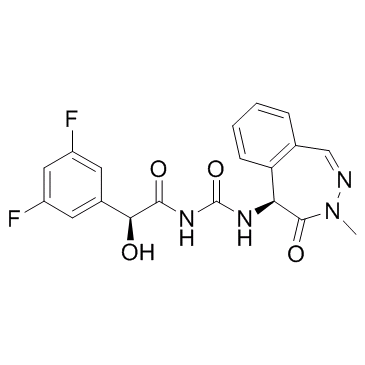| Description |
BMS 433796 is a γ-secretase inhibitor with Aβ lowering activity in a transgenic mouse model of Alzheimer's disease.
|
| Related Catalog |
|
| Target |
γ-secretase[1]
|
| In Vitro |
BMS-433796 cause a concentration-dependent decrease in [3H]IN973 binding, with IC50 value of 1.2 nM, very similar to the IC50 values for inhibition of Aβ40 in human embryonic kidney cells overexpressing the Swedish mutation of APP of 0.8 nM, respectively, and for inhibition of Aβ42 of 0.4 nM, respectively[2].
|
| In Vivo |
BMS 433796 is characterized in pharmacokinetic studies in male Sprague-Dawley rats. Following a 10-min intravenous infusion at 2.3 μmol/kg in PEG-400, the total body clearance of 40 is 5.2±0.82 mL/min/kg (means±SEM; n=3), indicating low clearance. The apparent terminal elimination half-life is 4.6±0.48 h. Oral administration of a PEG-400 suspension at 35 μmol/kg shows an oral bioavailability of 31% with prolonged absorption. BMS 433796 has satisfactory metabolic stability in human liver microsomal preparations and is not an inhibitor of human CYPs (IC50>100 μM)[1]. Brain Aβ40 is reduced as a result of administering BMS-433796 in a dose-dependent manner, with ED50 value of 2.4 mg/kg, respectively[2].
|
| Kinase Assay |
The binding assay is performed in duplicate in an assay volume of 250 μl consisting of 25 μL of buffer (50 mM HEPES and 0.1% CHAPSO, pH 7.0) or 10 μM BMS-433796 to define nonspecific binding, 25 μL of buffer containing [3H]IN973, and 200 μL of homogenate (200 μg of protein). Incubation is initiated by the addition of the membrane homogenates at 25°C for 1 h. Binding reactions are terminated by filtration through Whatman GF/B filters using a cell harvester. Unbound radioactivity is removed by rinsing the filters with ice-cold wash buffer (PBS; pH 7.0). Filters are counted using a 2500TR liquid scintillation counter. Saturation data are analyzed by the nonlinear regression analysis program LIGAND. Binding curves are best fit to a one-site model, yielding the equilibrium dissociation constant (Kd) and the maximal number of binding sites (Bmax)[2].
|
| References |
[1]. Prasad CV, et al. Discovery of (S)-2-((S)-2-(3,5-difluorophenyl)-2-hydroxyacetamido)-N-((S,Z)-3-methyl-4-oxo-4,5-dihydro-3H-benzo[d][1,2]diazepin-5-yl)propanamide (BMS-433796): a gamma-secretase inhibitor with Abeta lowering activity in a transgenic mouse model of Alzheimer's disease. Bioorg Med Chem Lett. 2007 Jul 15;17(14):4006-11. [2]. Goldstein ME, et al. Ex vivo occupancy of gamma-secretase inhibitors correlates with brain beta-amyloid peptide reduction in Tg2576 mice. J Pharmacol Exp Ther. 2007 Oct;323(1):102-8.
|
